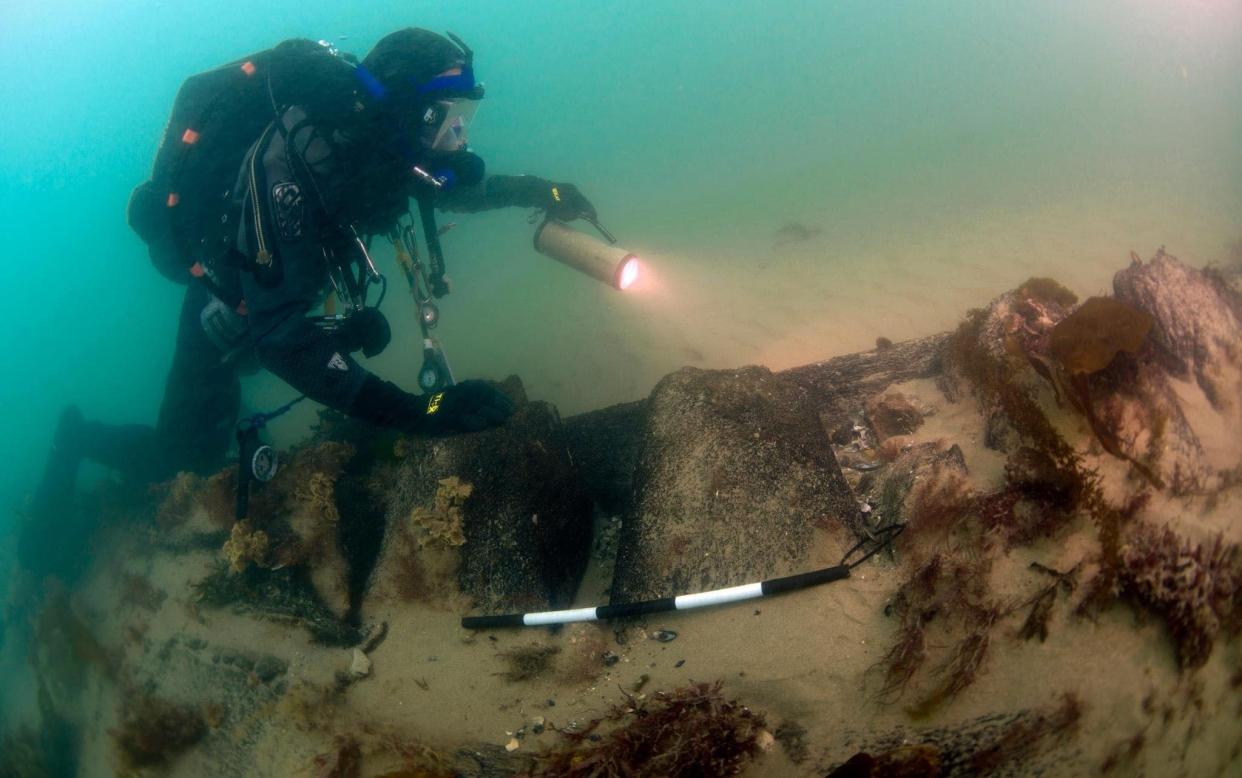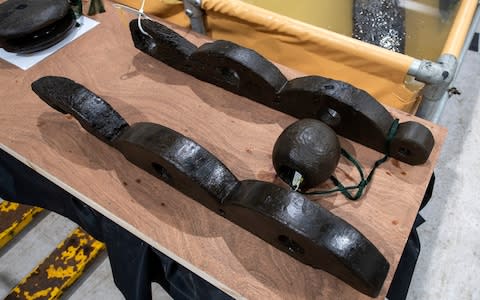Excavation of first HMS Invincible reveals original hand cut water-level markers survived 200 years under the sea

The excavation of the first HMS Invincible has revealed the original hand cut water-level markers have survived 200 years under the sea.
Swivel guns, a gun port lid, the main stay and even a mop head and bucket were recovered. Other finds include clay pipes, wig curlers and a number of bottles – some with their contents still preserved.
Archaeologists and divers from Bournemouth University and the Marine Archaeology Sea Trust, supported by the National Museum of the Royal Navy, say the important and historic finds will help bring understanding to life on-board an 18th Century Royal Navy warship.
The most significant excavation of the three-year project was to lift the cutwater; the front most part of the ship. Weighing over 5.8 tonnes and over 9 metres in length, the piece still has its original hand-carved draft marks cut into it, showing how deep the ship sat in the water.
Professor David Parham of Bournemouth University said: “Because of her design, and how that was then used by the British fleet...she’s a key component in the development of naval ship building in the 18th Century."

The majority of the wreck of HMS Invincible will remain on the sea bed as it is considered too fragile to move.
However, items such as ship's rigging, gunnery stores and personal possessions have been brought to the surface. As many items had not been disturbed from their original locations, it was possible to learn much about life in the Royal Navy in Georgian times.
Dan Pascoe, the site’s archaeologist, said: “It is probably the best-preserved 18th Century warship in the UK. It was full of stores, provisions, and equipment and so much of the ship survives on the seabed and we’ve recovered thousands of artefacts.
“It is those artefacts that tell us about life on-board a warship during the Georgian period. You get such wonderful preservation on the wreck of the Invincible because so much of it survives, you find these artefacts in their original location on the ship and that tells you so much about life on-board.”

Originally named L’Invincible, the ship was built in France on the banks of the River Charente, at Rochefort in 1744. The 74-gun warship was designed to fight all around the world, protecting France’s overseas Empire and merchant fleets.
However, having been captured by Admiral Anson of the Royal Navy at the first Battle of Finisterre on May 3, 1747, she ran aground and sank off the coast of the Solent in 1758. She was rediscovered in 1979 by a local fisherman and designated an Historic Wreck in 1980.
L’Invincible’s fine lines had attracted great attention and influenced the design of future British warships, leading to lower, sleeker and more stable vessels. Within half a century, most of the Royal Navy ships had been based on her design.
Her career in the Royal Navy came to an unexpected end. On Feb 19, 1757 HMS Invincible was given orders to weigh anchor and begin the voyage to Louisbourg (modern day Nova Scotia) to fight the French.
However, a series of calamitous events led to her wrecking on a shallow sand bank. She is thought to be the most complete and best-preserved remains of a warship from the mid-18th century.
Jessica Berry of the Maritime Archaeological Sea Trust said: "We have a really good idea now of how they lived and worked, and how incredibly organised they were.
"Everything is labelled and we found the equivalent of the broom cupboard with everything still on shelves. It just shows the incredible organisation of the Royal Navy."

Due to the work of the team, the excavation is now complete and Historic England has been able to remove the site from its Heritage At Risk Register.
Recovered items will go on permanent display at the National Museum of the Royal Navy, in Portsmouth, for the public to view.

 Yahoo News
Yahoo News 
